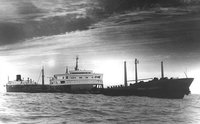40 years ago, Englebert Humperdinck was at number one with Release Me, The Beatles were putting the finishing touches to Sgt Pepper and London was really starting to swing. Martin Luther King was leading marches across the USA protesting against the Vietnam War, which was going from bad to worse. But the eyes of the world were on the Isles of Scilly ? and for all the wrong reasons.
On 18 March, 1967, the Torrey Canyon, the first of the big supertankers, struck the Seven Stones reef, carrying a cargo of 120,000 tons of crude oil. It was the world’s first man-made environmental disaster.
31,000,000 gallons of oil leaked from the 974ft 120,000- ton tanker and spread up the English Channel, killing almost everything it touched along the south coast of Britain and the Normandy shores of France, and polluting hundreds of miles of coast for months afterward.
The Torrey Canyon was an enormous ship - almost 1000ft long, with a beam of 125ft and 68ft draught. Built in 1959 in the United States, its original capacity of 60,000 tons had been doubled to 120,000 in Japan.
At the time of the accident she was chartered to British Petroleum. Her final voyage had begun in Mena al-Ahmadi in Kuwait on February 19 1967 with a full cargo of oil and she had reached the Canary Islands on 14 March. Four days later she was bound for Milford Haven in Wales, via the Isles of Scilly.
The vessel struck Pollard’s Rock on the Seven Stones reef at 17 knots.
The Captain had been aware of the problem before she struck, but there was no time to take evasive action. Such was the ship’s momentum at speed that she needed five miles to make an effective turn. The crew of the Seven Stones lightship, two miles off the reef, said they realised the tanker was in danger when she was still a mile away.
The Torrey Canyon was the first big ecological disaster and no protocols existed about how to deal with it.
An initial attempt to refloat her was abandoned after a Dutch salvage expert was killed in an explosion on board.
After being stranded on the reef for several days the ship broke apart and smaller boats towing giant foam booms failed to contain the slick.
The Fleet Air Arm and the RAF bombed the wreck in an effort to sink her and burn off the oil. The operation was declared a success, but the Navy was criticised because about 25% of the 42 bombs dropped onto the ship, a very large and very stationary target, had missed. A large number also failed to detonate. The RAF and the Navy subsequently dropped napalm and petrol in an attempt to burn off the oil.
One Islands local has a vivid memory of the smoke. Looking out from Deep Point, with everyone else on St Mary’s, on a fine Sunday afternoon in late March, it was ?black as night and rose for miles into the sky’.
“The planes were too far away to see in the smoke, but there were occasional flashes, though the wind carried the sound of the explosions toward the mainland,” he said.
Around 120 miles of the coast of Cornwall and 50 miles of the French coast was contaminated. Estimates of between 15 and 30,000 sea birds were killed before the 270sq mile oil dispersed. The heavy use of detergents used to break up the slick only caused further damage.
Only seven miles away, the Isles of Scilly were particularly vulnerable. But thanks to constant south westerly winds almost no oil came ashore on the Islands, while Cornwall was devastated. A local recalls, ‘As a little boy, I remember being very disappointed that we had no oil on the Scillies. My mum told me I was a stupid boy. It looked very exiting on the news.”
The vessel was bombed for two days until it finally sank on 30 March 1967 and the oil was eventually dispersed by favourable weather.
An inquiry in Liberia, where the ship was registered, found the captain, Pastrengo Rugiati, was to blame because he took a short cut to save time.
Since the Torrey Canyon there have been other wrecks involving tankers. The Exxon Valdez leaked 11,000,000 gallons of oil into Prince William Sound, Alaska, in March 1989. Due to its proximity to the shore the environmental damage was much greater. But due to lessons learned in part from the Torrey Canyon, the clean up and containment was much more effective.
The Torrey Canyon is now a haven for marine wildlife and a regular spot for divers.
On a more positive note, there is an unconfirmed story that up to 75% of the detonators used in the bombs dropped on the tanker were faulty. The Ministry of Defence later sold their entire stock to the Argentine air force. The next time they failed to detonate was in the hulls of the British Ships during the Falklands conflict.







